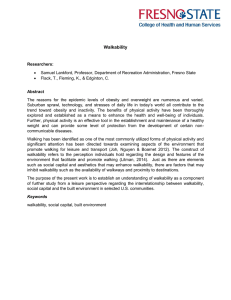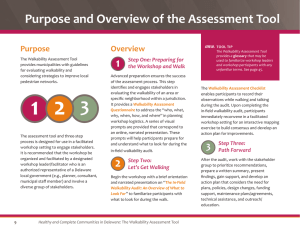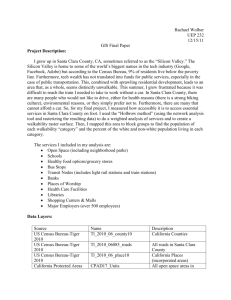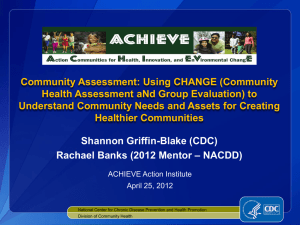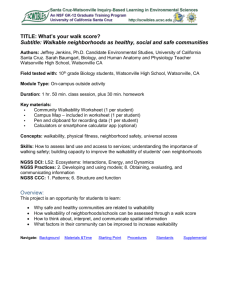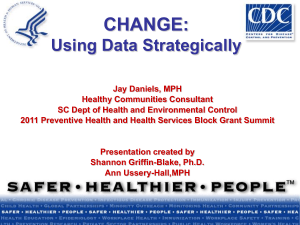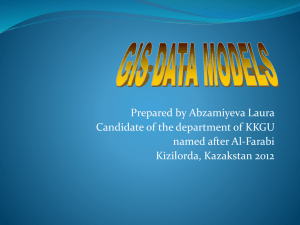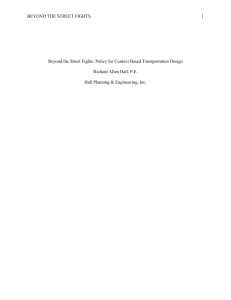GIS Final Paper
advertisement
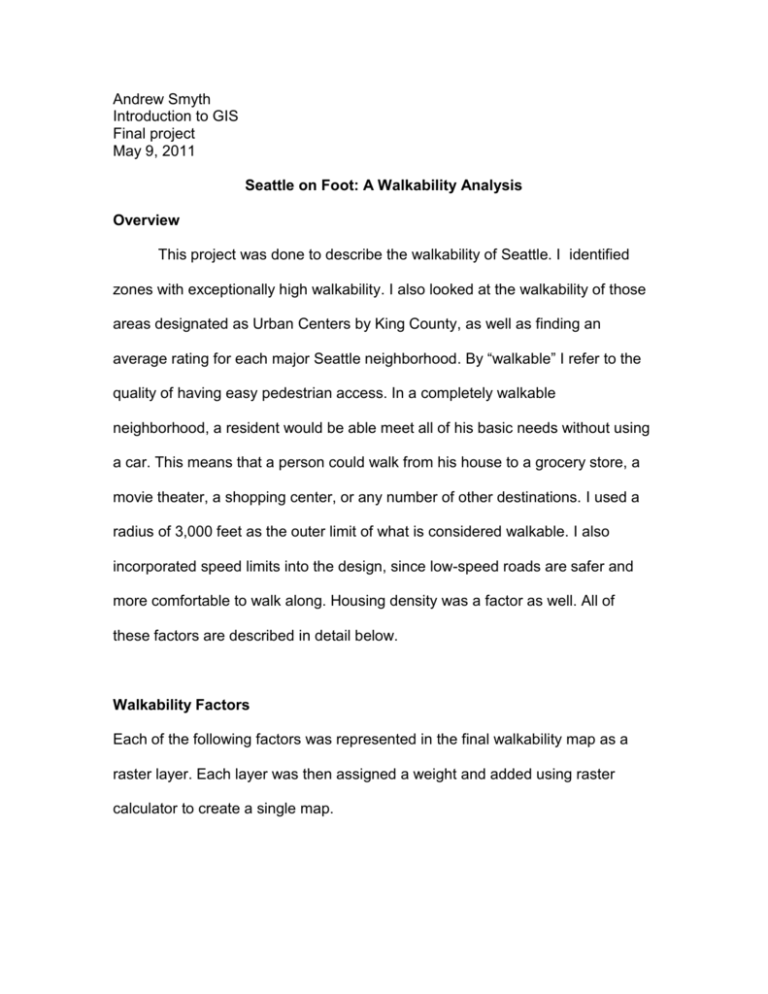
Andrew Smyth Introduction to GIS Final project May 9, 2011 Seattle on Foot: A Walkability Analysis Overview This project was done to describe the walkability of Seattle. I identified zones with exceptionally high walkability. I also looked at the walkability of those areas designated as Urban Centers by King County, as well as finding an average rating for each major Seattle neighborhood. By “walkable” I refer to the quality of having easy pedestrian access. In a completely walkable neighborhood, a resident would be able meet all of his basic needs without using a car. This means that a person could walk from his house to a grocery store, a movie theater, a shopping center, or any number of other destinations. I used a radius of 3,000 feet as the outer limit of what is considered walkable. I also incorporated speed limits into the design, since low-speed roads are safer and more comfortable to walk along. Housing density was a factor as well. All of these factors are described in detail below. Walkability Factors Each of the following factors was represented in the final walkability map as a raster layer. Each layer was then assigned a weight and added using raster calculator to create a single map. Weight 14 14 12 12 10 10 8 8 6 3 3 Raster Layer Grocery Stores Bus Stops Shopping Centers Housing Density Average Speed Limit Parks and Recreation Restaurants Movie Theaters Public Libraries Elementary Schools Middle and High Schools Table 1: Walkability factors and weights Grocery stores were deemed to be the most essential, and were weighted highest accordingly. Bus stops were ranked highly as well because public transportation enormously enhances a person’s ability to live with a car. Shopping centers were ranked somewhat high as well, though better data would incorporate other types of shopping or commercial density in addition to major shopping centers. The speed limit factor expresses the average speed limit of roads in each census block, using a spatial join. This is because slower roads are generally friendlier to pedestrians, have more crosswalks, sidewalks, and can be crossed more easily. Lower speed limits were given a higher rank. Housing density was included in the analysis because neighborhoods are only truly walkable if people can live there. One paper which assessed the value of walkability factors says of that denser neighborhoods “include mixed-use development,…improve accessibility to [a] variety of complementary activities, and thus, increase[s] utility.” (Leslie et. al, 93). “Parks and recreation” included points for parks, as well as playgrounds, community centers, locations like the zoo and the aquarium, landmarks like the space needle, and other points of interest. Restaurants, movie theaters and libraries were deemed to be less than essential, but still worthy of inclusion. Schools were included, but since they apply only to families, and because bus service is available, they were ranked lowest. Elementary schools were included separately from others in order to give children a smaller walking radius (1,500 feet as opposed to 3,000 feet). About the Data: Layer Common points of interest (narrowed to parks and recreation, also shopping centers, libraries) Bus stops Grocery Stores Restaurants Movie Theaters Schools Source (links to metadata) King County Website Source scale http://www5.king county.gov/gisda taportal/ Not available Year represen ted 2011 King County http://www5.king county.gov/gisda taportal/ www.referenceu sa.com Not available 2011 www.referenceu sa.com n/a www.referenceu sa.com n/a http://www5.king county.gov/gisda taportal/ “aligned to school 2011 buildings using digital air photography,” scale not specified. Not available 2006 Geocoded from Reference USA data Geocoded from Reference USA data Geocoded from Reference USA data King County Transportation network (roads) King County Census Block Groups 2010 King County Census Blocks King County http://www5.king county.gov/gisda taportal/ http://www5.king county.gov/gisda taportal/ http://www5.king county.gov/gisda taportal/ n/a U.S. Geological Survey (USGS) 1:100,000-scale Digital Line Graph (DLG), USGS 1:24,000-scale quadrangles U.S. Geological Survey (USGS) 1:100,000-scale Digital Line Graph (DLG), USGS 2010 2010 Urban Centers King County City Boundaries King County Hydro King County Address Points (used for geocoding reference USA data) King County http://www5.king county.gov/gisda taportal/ http://www5.king county.gov/gisda taportal/ http://www5.king county.gov/gisda taportal/ http://www5.king county.gov/gisda taportal/ 1:24,000-scale quadrangles Not available 2010 Not available 2011 Not available 2007 Not available 2011 Table 2: GIS data used Preparing the data: 1. Removed freeways, highways, on-ramps from transportation layer using an attribute query. 2. King County datasets were narrowed to the Seattle boundary using a location query. 3. Created address locator based on address point layer 4. Geocoded Reference USA, corrected unmatched addresses Creation of the Walkability Map 5. Created a network dataset from the transportation layer. 6. Used Network Analyst to create service areas around destination points (theaters, grocery stores etc.) with a search radius of 3,000 feet, and breaks every 600 feet for a total of five zones. Here is a buffer zone created around a public library 7. Used Spatial Analyst to convert the buffer zones to raster layers Library data after being converted to raster form. 8. Reclassified raster layers so that the nearest part of the buffer zone scored highest, and the farthest parts scored lowest. 9. Weighted each layer according to Table 1. 10. Used raster calculator to add all layers together with this equation: outraster4 = ([Reclass_groc2] * 14 + [Reclass_bus_2] * 14 + [Reclass_spee3] * 10 + [Reclassified Housing Density] * 12 + [Reclass_shop2] * 12 + [Reclass_rest2] * 8 + [Reclass_park1] * 10 + [Reclass_movi2] * 8 + [Reclass_libr4] * 6 + [Reclass_elem2] * 3 + [Reclass_hsch2] * 3) 11. Used zonal statistics to calculate average walkability scores for Urban Centers and for Neighborhoods. 12. Prepared maps from results of the analysis. Difficulties Encountered Initially, I had wanted to use parcel data to create a commercial density raster layer. Unfortunately, after spending much time attempting to join the assessor’s data to the parcel shapefile, the data turned out to be incomplete, and could not be used. Shopping center points were substituted. The overlay tool in Spatial Analyst also failed to work. The tool worked only when adding a handful of layers, and could not seem to handle all eleven at once. Raster calculator was successfully used instead. Besides these two problems, the analysis went smoothly, with only very minor and easily solved issues besides the aforementioned. Success of the Approach This approach to walkability seems to have worked well. The final map meets my expectations, and agrees with my personal knowledge of Seattle for the most part. It is hard to say, of course, whether appropriate weights were given to each of the factors. I feel confident, however, that the results are substantially correct. There are some factors not taken into account here which might have improved results. Elevation data was not used. Seattle is a very hilly city, and this surely limits walking range for many people. If I could do this again, I would definitely include that data. It would also be ideal to have a network dataset that had sidewalk data. Unfortunately, this was not available. Also, banks and ATMs, street junction density, location of major workplaces, bike routes, and other commonly used factors were not chosen, and may have affected results. Related Reading Julian D. Marshall, Michael Brauer and Lawrence D. Frank “Healthy Neighborhoods: Walkability and Air Pollution.” Environmental Health Perspectives. 2009. vol 117, no 11. pages 1752-1759. <http://www.jstor.org/stable/40382462> This was a study done in Vancouver BC to assess the relationship of walkability of a neighborhood, which entails greater physical activity and exposure to the outdoors, and air pollution and its health impacts. Unfortunately, the authors do not go into much depth in terms of discussing their GIS methodology for determining walkability, but the factors they incorporated gave me some ideas. Robert David Stevens. Walkability Around Neighborhood Parks: An Assessment of Four Parks in Springfield, Oregon. MA Terminal Project. University of Oregon, Eugene, OR, 2005. <https://scholarsbank.uoregon.edu/xmlui/bitstream/handle/1794/1288/steve ns_thesis.pdf?sequence=1> This was an extensive study conducted in Springfield Oregon. The author investigated the walkability of four different parks. It provided some good background on what has been done in researching walkability questions (as of 2005). The research question is a little different than what I am doing, but some of the factors he used for his scoring system may be applicable to my project. Prasanta Bhattarai, A GIS Based Walkability Analysis. Independent Study Project, University at Buffalo, 2007. <http://www.vattarai.com/mup_project/other_projects/Independent_study_ report.pdf> This is an independent study project of a student at the University at Buffalo. The paper itself has some issues with writing and reasoning, but it did help me think through what sorts of variables I ought to consider. The author considers population density, housing density, General Commercial Area, Vacant land, Restaurant and Ding area, Parks and Parkways, Tree shade densities, Bike paths, bus stops, speed limits, street junction density, and traffic volume. The maps are sometimes unclear, but the methodology seems sound. It prompted me to create a housing density map. Eva Leslie et al. “Objectively Assessing Walkability of Local Communities: Using GIS to Identify the Relevant Environmental Attributes.” GIS for Health and the Environment. (Springer Berlin Heidelberg, 2007). <http://www.springerlink.com/content/l134ng3736002458/fulltext.pdf> This is a chapter of a book (available online) that attempts to objectively determine factors which would be relevant to a GIS walkability analysis. This proved very useful, since most other attempts to find factors seem to be based more or less on personal opinion, with little explanation. This chapter gives clear reasons for why each variable should be considered a contributor to walkability.
